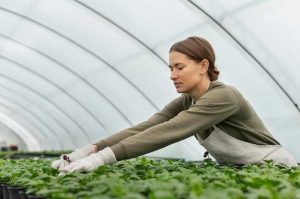

In the realm of farming and cultivation, the landscape is undergoing a remarkable transformation. The agricultural sector is experiencing a wave of revolutionary advancements that are reshaping the way we grow, harvest, and sustain our food sources. These groundbreaking innovations and pioneering technologies are propelling the industry towards a future characterized by efficiency, sustainability, and enhanced productivity.
With each passing day, the agricultural domain is witnessing a paradigm shift, driven by a relentless pursuit of excellence and a commitment to harnessing the power of science and technology. From precision farming techniques to automated machinery, from genetic engineering to vertical farming, the possibilities seem boundless. This new era of agriculture is not only redefining the way we produce food but also addressing the pressing challenges of population growth, climate change, and resource scarcity.
One of the key driving forces behind this agricultural revolution is the integration of cutting-edge technologies. These transformative tools are empowering farmers and researchers to optimize their practices, mitigate risks, and maximize yields. From the utilization of drones for crop monitoring to the implementation of artificial intelligence for data analysis, technology is revolutionizing every aspect of the agricultural value chain. The convergence of biology, chemistry, and engineering is giving rise to a new breed of farmers who are equipped with the knowledge and tools to navigate the complexities of the modern agricultural landscape.
Moreover, sustainability lies at the heart of these advancements. As the world grapples with the urgent need to reduce its ecological footprint, the agricultural industry is stepping up to the challenge. Innovations such as hydroponics, aquaponics, and vertical farming are enabling us to cultivate crops in urban environments, utilizing limited space and resources. The integration of renewable energy sources, smart irrigation systems, and precision application of fertilizers and pesticides are further minimizing the environmental impact of agriculture. This sustainable approach not only ensures food security but also safeguards the delicate balance of our ecosystems for generations to come.
Vertical Farming: Revolutionizing Crop Production
Vertical farming is a groundbreaking agricultural technique that is transforming the way crops are grown. This innovative approach to cultivation involves growing plants in vertically stacked layers, utilizing limited space and resources efficiently. By harnessing advanced technologies and sustainable practices, vertical farming is revolutionizing crop production and offering a promising solution to the challenges faced by traditional agriculture.
Maximizing Space and Efficiency
One of the key advantages of vertical farming is its ability to maximize space utilization. By growing crops in vertically stacked layers, vertical farms can produce significantly higher yields compared to traditional farming methods. This vertical arrangement allows for the cultivation of crops in urban areas, where land availability is limited. Additionally, the controlled environment in vertical farms enables year-round cultivation, eliminating the dependence on seasonal changes and weather conditions.
Advanced Technologies and Sustainable Practices
Vertical farming relies on a range of advanced technologies and sustainable practices to optimize crop production. These include the use of artificial lighting systems, hydroponics, and aeroponics. Artificial lighting systems provide the necessary light spectrum for plant growth, allowing crops to thrive in indoor environments. Hydroponics, a soil-less cultivation technique, involves growing plants in nutrient-rich water solutions, reducing the need for soil and minimizing water usage. Aeroponics, on the other hand, involves growing plants in a mist environment, further conserving water resources.
| Advantages of Vertical Farming | Challenges and Limitations |
|---|---|
| 1. Increased crop yields | 1. High initial setup costs |
| 2. Year-round cultivation | 2. Energy consumption |
| 3. Reduced water usage | 3. Limited crop variety |
| 4. Minimized pesticide use | 4. Technical expertise required |
Despite the numerous advantages, vertical farming also faces certain challenges and limitations. High initial setup costs, energy consumption, limited crop variety, and the need for technical expertise are some of the obstacles that need to be addressed. However, ongoing research and development in the field of vertical farming are continuously improving its efficiency and sustainability, making it a promising solution for the future of crop production.
Precision Agriculture: Enhancing Efficiency and Sustainability
In the realm of modern farming, there exists a revolutionary approach known as precision agriculture. This innovative method is transforming the way farmers cultivate crops and manage their land, leading to increased efficiency and sustainability. By harnessing cutting-edge technologies and data-driven insights, precision agriculture empowers farmers to make informed decisions, optimize resource utilization, and minimize environmental impact.
Optimizing Resource Utilization
Precision agriculture leverages advanced technologies such as remote sensing, GPS, and drones to gather precise data about soil conditions, weather patterns, and crop health. By analyzing this data, farmers can identify specific areas within their fields that require attention, such as nutrient deficiencies or pest infestations. This targeted approach allows for the precise application of fertilizers, pesticides, and water, minimizing waste and maximizing resource efficiency. By optimizing resource utilization, farmers can reduce costs, increase yields, and minimize the environmental footprint of their operations.
Minimizing Environmental Impact
One of the key benefits of precision agriculture is its ability to minimize the environmental impact of farming practices. By accurately assessing the needs of each individual plant or section of land, farmers can avoid over-application of chemicals and fertilizers, reducing the risk of water and soil pollution. Additionally, precision agriculture enables the implementation of conservation practices such as controlled traffic farming and variable rate application, which further reduce soil erosion and nutrient runoff. By adopting these sustainable practices, farmers can preserve natural resources, protect biodiversity, and contribute to a healthier ecosystem.
In conclusion, precision agriculture is revolutionizing the farming industry by enhancing efficiency and sustainability. Through the use of advanced technologies and data-driven insights, farmers can optimize resource utilization and minimize environmental impact. By embracing precision agriculture, the future of farming holds great promise for increased productivity, profitability, and environmental stewardship.
Robotics and Automation: Transforming Farm Operations
In the realm of agriculture, the integration of robotics and automation has revolutionized the way farm operations are conducted. This section explores the profound impact of these technological advancements on the industry, highlighting the transformative potential they hold.
Enhancing Efficiency and Productivity
Robotics and automation systems have emerged as game-changers in the agricultural landscape, offering unparalleled opportunities to enhance efficiency and productivity. By automating repetitive tasks such as planting, harvesting, and irrigation, farmers can optimize their operations and allocate resources more effectively. This not only reduces labor costs but also minimizes human error, leading to higher crop yields and improved overall productivity.
Promoting Sustainability and Environmental Stewardship
Beyond efficiency gains, robotics and automation also play a crucial role in promoting sustainability and environmental stewardship within the agricultural sector. With the ability to precisely monitor and control various parameters, such as water usage, fertilizer application, and pest management, these technologies enable farmers to adopt more sustainable practices. By minimizing resource wastage and reducing the reliance on harmful chemicals, robotics and automation contribute to the preservation of natural resources and the protection of ecosystems.
Artificial Intelligence: Optimizing Decision-Making in Agriculture
Advancements in technology have revolutionized the agricultural industry, and one of the most promising innovations is the integration of artificial intelligence (AI). AI is transforming the way decisions are made in agriculture, offering optimized solutions for various challenges faced by farmers and industry professionals.
Enhanced Efficiency and Precision
AI-powered systems enable farmers to make data-driven decisions with enhanced efficiency and precision. By analyzing vast amounts of data, AI algorithms can identify patterns, predict outcomes, and provide valuable insights. This empowers farmers to optimize their operations, from crop selection and planting strategies to irrigation and pest control.
Moreover, AI can assist in monitoring and managing crop health by analyzing real-time data from sensors, drones, and satellite imagery. This enables early detection of diseases, nutrient deficiencies, or pest infestations, allowing farmers to take proactive measures and minimize crop losses.
Smart Resource Management
AI technologies also play a crucial role in optimizing resource management in agriculture. By integrating AI with IoT (Internet of Things) devices, farmers can monitor and control various parameters such as soil moisture, temperature, and humidity. This enables precise irrigation and fertilization, reducing water and nutrient wastage while maximizing crop yield.
Furthermore, AI-powered predictive models can help farmers optimize their use of resources by considering factors such as weather conditions, market demand, and historical data. This allows for efficient planning of planting schedules, harvesting, and storage, minimizing waste and ensuring timely delivery to meet market demands.
In conclusion, the integration of artificial intelligence in agriculture is revolutionizing decision-making processes. By harnessing the power of AI, farmers can optimize their operations, enhance efficiency and precision, and make informed choices for sustainable and profitable farming practices.
Gene Editing: Advancing Crop Improvement and Disease Resistance
Gene editing techniques have emerged as a powerful tool in the field of agriculture, revolutionizing crop improvement and enhancing disease resistance. By manipulating the genetic material of plants, scientists are able to introduce desirable traits and eliminate harmful ones, paving the way for a more sustainable and resilient agricultural industry.
Enhancing Crop Yield and Quality

Gene editing allows researchers to precisely modify the DNA of crops, enabling them to enhance yield and improve the quality of agricultural products. By targeting specific genes responsible for traits such as drought tolerance, pest resistance, and nutrient uptake, scientists can develop crops that are better equipped to withstand environmental challenges and produce higher yields.
Furthermore, gene editing techniques can be used to enhance the nutritional content of crops, addressing malnutrition and improving human health. By introducing genes that increase the levels of essential vitamins, minerals, and antioxidants, crops can be fortified with nutrients that are crucial for a balanced diet.
Bolstering Disease Resistance
Diseases pose a significant threat to agricultural productivity, leading to substantial crop losses and economic damage. Gene editing offers a promising solution by enabling the development of crops with enhanced disease resistance. By identifying and modifying genes associated with susceptibility to diseases, scientists can create plants that are more resilient and less prone to infections.
Additionally, gene editing techniques can be used to introduce natural defense mechanisms into crops, making them more resistant to pests and pathogens. By enhancing the plant’s ability to recognize and respond to threats, farmers can reduce their reliance on chemical pesticides, promoting environmentally friendly and sustainable farming practices.
- Improved crop yield and quality
- Enhanced nutritional content
- Increased disease resistance
- Reduced reliance on pesticides
In conclusion, gene editing technologies hold immense potential for advancing crop improvement and disease resistance in the agricultural industry. By harnessing the power of genetic manipulation, scientists can develop crops that are more productive, nutritious, and resilient, ensuring a sustainable and secure food supply for future generations.
Blockchain Technology: Ensuring Transparency and Traceability in the Food Supply Chain
In the rapidly evolving landscape of the agricultural industry, the adoption of innovative technologies is crucial to address the challenges and meet the demands of the future. One such technology that holds immense potential is blockchain. Blockchain technology offers a decentralized and transparent system that can revolutionize the way we track and trace the journey of food from farm to fork. By ensuring transparency and traceability in the food supply chain, blockchain technology has the power to enhance food safety, reduce fraud, and build trust among consumers.
Enhancing Transparency in the Food Supply Chain
Transparency is a fundamental aspect of the food supply chain, as consumers increasingly demand to know where their food comes from and how it is produced. Blockchain technology can provide a solution by creating an immutable and transparent ledger that records every transaction and movement of food throughout the supply chain. This allows consumers to access real-time information about the origin, quality, and safety of the products they consume. By providing a clear and auditable record of the entire supply chain, blockchain technology ensures that no information is hidden or altered, promoting trust and accountability.
Ensuring Traceability for Food Safety
Food safety is a critical concern for both consumers and industry stakeholders. In the event of a foodborne illness outbreak or contamination, it is essential to quickly identify the source of the problem and remove the affected products from the market. Blockchain technology can enable rapid traceability by providing a decentralized and tamper-proof system for tracking the movement of food products. By recording every step of the supply chain, from production to distribution, blockchain technology allows for efficient and accurate identification of the source of contamination, minimizing the impact on public health and preventing further spread.
| Benefits of Blockchain Technology in the Food Supply Chain |
|---|
| Enhanced transparency and trust among consumers |
| Improved food safety and rapid traceability |
| Reduced fraud and counterfeit products |
| Efficient supply chain management and optimization |
| Streamlined regulatory compliance |
In conclusion, blockchain technology has the potential to revolutionize the food supply chain by ensuring transparency and traceability. By leveraging the decentralized and transparent nature of blockchain, the agricultural industry can enhance consumer trust, improve food safety, and streamline supply chain management. As the industry continues to embrace technological advancements, blockchain technology is poised to play a pivotal role in shaping the future of agriculture.





